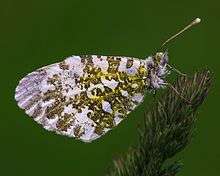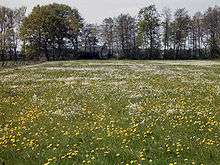Anthocharis cardamines
| Orange tip | |
|---|---|
_male.jpg) | |
| Male, Oxfordshire | |
 | |
| Female, Rosenfeld, Germany | |
| Scientific classification | |
| Kingdom: | Animalia |
| Phylum: | Arthropoda |
| Class: | Insecta |
| Order: | Lepidoptera |
| Division: | Rhopalocera |
| Family: | Pieridae |
| Tribe: | Anthocharini |
| Genus: | Anthocharis |
| Species: | A. cardamines |
| Binomial name | |
| Anthocharis cardamines (Linnaeus, 1758) | |
| Subspecies | |
|
See text. | |
Anthocharis cardamines, the orange tip, is a butterfly in the family Pieridae.
Appearance, behaviour and distribution
The common name derives from the bright orange tips of the male's forewings. The males are a common sight in spring, flying along hedgerows and damp meadows in search of the more reclusive female which lacks the orange and is often mistaken for one of the other 'white' butterflies. The undersides are mottled green and white and create a superb camouflage when settled on flowerheads such as cow parsley and garlic mustard (Alliaria petiolata).[1] The male is able to hide his orange tips by tucking the forewings behind the hindwings at rest. On close examination of the mottling, the green colour can be seen to be made up of a mixture of black and yellow scales. The butterfly is found across Europe, and eastwards into temperate Asia as far as Japan. The past 30 years have seen a rapid increase in the range of the orange tip in the UK, particularly in Scotland and Ireland, probably in response to climate change.
Lifecycle and foodplants
The female lays eggs singly on the flowerheads of cuckooflower (Cardamine pratensis) and garlic mustard (Alliaria petiolata) and many other species of wild crucifers, all of which contain substances called glucosinolates. Females are attracted to larger flowers, such as Hesperis matronalis, even though some such species are poor larval hosts. Selection of foodplants is triggered by the presence of mustard oils and their derivative glucosinolates, which (in Pierinae) are detected by chemosensory hairs on the fore-legs. Reproductive rate of females appears to be limited by difficulties in finding suitable hosts. As a consequence, the species has evolved to use a wide range of crucifers.
The eggs are white to begin with but change to a bright orange after a few days before darkening off just before hatching. Because the larvae feed almost exclusively on the flowers and developing seedpods there is rarely enough food to support more than one larva per plant. If two larvae meet one will often be eaten by the other to eliminate its competitor. Newly hatched larvae will also eat unhatched eggs for the same reason. To stop eggs from being laid on plants already laid on the female leaves a pheromone to deter future females from laying. There are five larval instars. The green and white caterpillar is attacked by several natural enemies (notably tachinid flies and braconid wasps).
Pupation occurs in early summer in scrubby vegetation near the foodplant, where they stay to emerge the following spring. Recent research suggests that the emergence of the butterfly may be delayed for as much as two years, thus insuring the species against unfavourable conditions in a given season.
-

Female imago
-

Mating, showing disruptively coloured underside
-

Egg
-

Larva
-

Pupa
Habitat

Damp pastures and meadows, damp woodland edges and glades, riverbanks, ditches, dykes, fens, railway cuttings and country lanes.


Subspecies
- A. c. cardamines (Linnaeus, 1758) – In the male of the name-typical cardamines the orange-red apical patch does not reach much further than to the black discocellular spot, the rest of the upperside being white with the exception of the narrowly lack apical margin, the proximal area of the forewing beneath and the underside of the hindwing being likewise white, the latter with greenish ("parsley") markings,which are rather variable in extent. In the female the orange-red apical patch is wanting, but the black apical marking is much wider and the black discocellular spot larger, otherwise the female similar to the male.
- A. c. meridionalis Verity, 1908
- A. c. turritis Ochsenheimer, 1816 – Among this race, erroneously called "Stammform" by German writers, there occur the following aberrations: turritis O. (= minor Cock.) (22 f), which is almost continued to the south of the distribution area, has a reduced orange patch, reaching only to the black median spot- hesperidis Newnham, a dwarfed form. — alberti Hoffm.: the orange patch more fiery, the black markings more prominent, the forewing beneath sulphur-yellow proximally, the underside of hindwing more strongly marmorated with green, bearing black dots.-lasthenia Mill.: the orange patch normal, the black median spot absent, the black apical and marginal spots present, the base of wings entirely white, the hindwing beneath spotted with very light greenish yellow. - ochrea Tutt: the hindwing almost entirely yellow, principally a female form. — immaculata Pabst: without black median spot to the forewing - quadripunctata Fuchs: all the wings with a black median spot above and below, this spot on the forewing above large and streak-like, anteriorly rounded off, truncate behind, the spot of the hindwing above thin and roundish, grey-black, beneath very large and deep black, situated within the green markings.
- A. c. progressa (Sovinsky, 1905) – Altai, Sayan, Transbaikalia - synonym sajana from East Sajan has the orange patch enlarged, the basal area of the forewing above yellowish, being deeper yellow beneath, the markings extensa. of the underside of the hindwing more regular in shape and lighter.
- A. c. septentionalis Wnukowsky, 1927 – Russian Far East
- A. c. phoenissa Kalchberg, 1894
- A. c. alexandra (Frances Hemming|Hemming, 1933) – Tian-Shan, Ghissar, Darvaz, Alai [cardamines orientalis Röber, [1907]; (preocc.) ] orientalis form, nov., from Buchara is very large, the orange patch of a deep tint and almost as large as in sajana, upperside of hindwing darkened in consequence of the strong development of the greenish markings of the underside, slightly yellowish: forewing beneath deep sulphur-yellow in the proximal portion of the cell, the yellowish green markings of the hindwing strongly widened, the white ground-colour being much reduced.
- A. c. hibernica (Williams, 1915) – Ireland
- A. c. koreana Matsumura, 1925 – Korea
- A. c. kobayashii Matsumura, 1925 – Sakhalin
- A. c. isshikii Matsumura, 1925 – Japan
- A. c. hayashii Fujioka, 1970 – Japan
- A. c. bambusaroides Huang & Murayama, 1992 – Xinjiang
Aberrations. Whether speciosa form. nov. Röber (22 g), from Southern Styria, is a local or individual form, we are at present not able to decide; very large, the orange patch fiery, distinct black spots on the discocellulars and at the distal margin of the hindwing, the green markings of the hindwing beneath almost regularly band-like [now considered an aberration. : ab. crocea form. nov. Röber Asia Minor (Kara-Hissar) a pretty aberration which has a lemon-yellow apical patch to the forewing, the patch being of the same size as in turritis.[2] [3]
See also
References
- ↑ Cott, Hugh (1940). Adaptive Coloration in Animals. pp. 74–75.
- ↑ Röber, Julius (1909). Pieridae, pp. 39-74, 374, pls. 17-27. In: Seitz, A. (ed.) Die Groß-Schmetterlinge der Erde. 1. Band. Die palaearctischen Tagfalter. – Stuttgart, Fritz Lehmann.
- ↑ Anthocharis cardamines, funet.fi
External links
| Wikispecies has information related to: Anthocharis cardamines |
| Wikimedia Commons has media related to Anthocharis cardamines. |